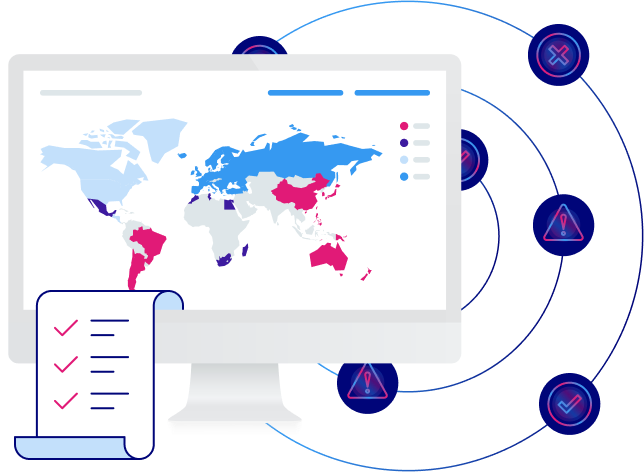-
Solutions
- AI Governance
- Responsible AI
- Geo-Specific Cookie Banner
- Consumer Preference Management
- Data Subject Request Automation
- Data Mapping and Vendor Risk Management
- Migrate
- Privacy, Vendor, and Risk Assessments
- Privacy Program Management
- Regulatory Guidance
- Privacy Program Consulting
- Certifications and Verifications
- International Data Transfers
Forrester TEI ROI of Privacy ReportTrustArc commissioned a Forrester study to analyze the potential benefits of using our platform and the Forrester team found ROI linked to efficiency, compliance, and decreased cost in data breaches.
Read the report -
Products Products Privacy Studio Overview
Automate consent and data subject rights compliance. Design seamless privacy experiences to enhance customer trust across your digital landscape.
- Cookie Consent Manager Effortlessly manage cookie consent for global compliance, ensuring a secure, personalized browsing experience.
- Consent & Preference Manager Easily manage and orchestrate customer consent and preferences across brands and channels.
- Individual Rights Manager Automate and streamline DSR workflows to ensure compliance and show your commitment to customer rights.
- Trust Center Centralize policies, disclosures, and trust-building information in a customizable no-code hub that speeds up deals.
Products Governance Suite OverviewStay ahead of privacy and compliance regulations. Simplify data privacy management and ensure data governance with cutting-edge apps.
- PrivacyCentral Centralize privacy tasks, automate your program, and seamlessly align with laws and regulations.
- Data Mapping & Risk Manager Gain full visibility and control of your data and accurately identify and mitigate risks.
- Assessment Manager Automate and score privacy assessments like PIAs and AI Risk, streamlining your compliance workflow.
- Nymity Research Get instant access to the latest in privacy regulations, legal summaries, and operational templates.
Products Assurance Services OverviewGain trust and credibility with leading privacy certifications from unbiased experts, backed by technology for unmatched privacy compliance assurance.
- Dispute Resolution
- TRUSTe Global CBPR and PRP Certification
- Data Privacy Framework Verification
- TRUSTe APEC CBPR and PRP Certification
- TRUSTe Responsible AI Certification
- TRUSTe Enterprise Privacy Certification
- CCPA/CPRA Validation
- GDPR Validation
- TRUSTe Data Collection Certification
- TRUSTe EDAA Privacy Certification
- Digital Advertising Alliance Validation
-
Regulations
- EU General Data Protection Regulation (GDPR)
- California Consumer Privacy Act (CCPA)
- Virginia Consumer Data Protection Act (CDPA)
- NIST AI Framework
- ISO/IEC 27001
EU Artificial Intelligence Act (EU AI Act)EU's regulation on the use of AI and the world's first comprehensive AI law.
Learn moreData Privacy Framework (DPF)Transatlantic data transfer mechanism for EU-U.S., UK, and Swiss-U.S. commerce.
Learn more - Resources
- Contact us
The National Institute of Standards and Technology (NIST) SP 800-53
The NIST SP 800-53 (Security and Privacy Controls for Information Systems and Organizations), is a set of security and privacy controls for federal information systems and organizations to help meet the Federal Information Security Management Act (FISMA) requirements.
Are you subject to NIST SP 800-53?
This framework is intended to serve a diverse audience, including:
-
Individuals with system, information security, privacy, or risk management and oversight responsibilities.
-
Individuals with system development responsibilities.
-
Individuals with logistical or disposition-related responsibilities, including program managers, procurement officials, system integrators, and property managers.
-
Individuals with security and privacy implementation and operations responsibilities.
-
Individuals with security and privacy assessment and monitoring responsibilities.
-
Commercial entities, including industry partners, producing component products and systems, creating security and privacy technologies, or providing services or capabilities that support information security or privacy.
Security and privacy controls under NIST SP 800-53
The NIST 800-53 framework provides a number of different controls and guidance across multiple security and access control families defined under a baseline of impact. These baselines are separated by high impact, medium impact, and low impact.
The controls in NIST 800-53 cover various aspects of cybersecurity including:
- Access control: managing access to information systems and data.
- Awareness and training: providing awareness and security training to employees, and elevated technical training for more privileged users.
- Audit and accountability: auditing and maintaining accountability of system activities.
- Configuration management: managing configuration changes to information systems.
- Identification and authentication: verifying the identity of users and devices.
- Individual participation: obtaining consent and authorizing privacy policies and practices.
- Incident response: detect, respond to, and recover from cybersecurity incidents.
- Maintenance: maintaining information systems and ensuring their integrity.
- Media protection: securing and protecting media access, use, storage, and transportation.
- Personnel security: screening internal and external personnel, setting up termination and transfer security policies.
- Physical and environmental protection: securing physical access to information systems.
- Planning: having strategies in place for comprehensive security architecture (such as defense in depth and third-party vendor security).
- Program management: having defined strategies for risk management, insider threats, and scaling architecture.
- Risk assessment: scanning vulnerabilities, having ongoing privacy impact, and risk assessments.
- Security assessment and authorization: penetration testing, and monitoring connections to public networks and external systems.
- System and services acquisition: implementing security across the system development lifecycle, new vendor contracts, and acquisitions.
- System and communications protection: partitioning applications, implementing cryptographic key management, and securing passwords and other sensitive data.
- System and information integrity: implementing system monitoring, alerting systems, and flaw remediation processes.

Mitigating Third-Party Risk: Best Practices for CISOs
Join us for an insightful and informative webinar as we delve into mitigating third-party risks. This webinar will provide essential strategies and best practices to ensure robust security and privacy measures when collaborating with external entities.
Achieve compliance
-
Privacy program development and compliance management Identify gaps and track compliance with PrivacyCentral – assess NIST SP 800-53 specifics and get automatic guidance on building out a sustainable privacy program.
-
Regulatory and standards guidance Stay ahead of regulatory and standard changes with expert guidance, ensuring your security and privacy practices remain compliant and up to date.

The information provided does not, and is not intended to, constitute legal advice. Instead, all information, content, and materials presented are for general informational purposes only.




